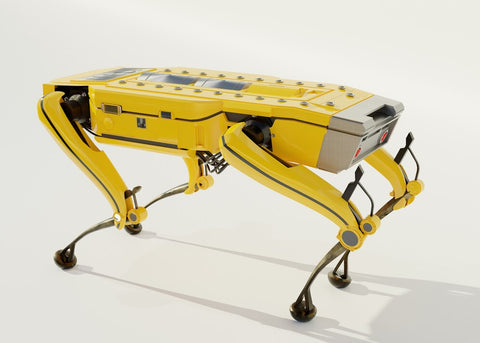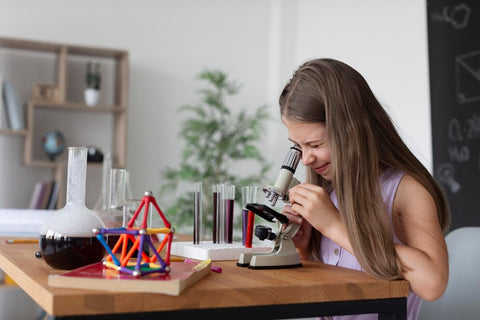In the ever-evolving landscape of education, fostering creativity and curiosity in children is paramount. STEM (Science, Technology, Engineering, and Mathematics) education provides an excellent platform for young minds to explore, discover, and innovate.
Integrating hands-on projects into learning not only makes the concepts tangible but also transforms education into an exciting adventure.
In this blog, we'll delve into 20 DIY STEM projects are designed to unlock creativity and make learning an enjoyable journey for kids.
1. DIY Solar-Powered Cars
Kickstarting our list is an engaging project that combines science and engineering: building solar-powered cars. This project introduces kids to the fundamentals of solar energy and mechanics. Gather materials like small motors, solar panels, wheels, and a lightweight frame. Guide the children in assembling their cars and watch as they grasp the concepts of harnessing renewable energy while having a blast with their miniature vehicles.
2. Paper Circuit Artwork
Merge technology with creativity by introducing paper circuit artwork. This project integrates basic electrical circuits into artistic creations using conductive materials, LEDs, and batteries. Kids can design greeting cards, interactive posters, or even illuminate their drawings. This hands-on experience instills a basic understanding of circuits and encourages artistic expression.
3. DIY Volcano Eruption
Transport your young scientists into geology with a classic yet enthralling experiment: the volcano eruption. Combine chemistry and earth science by creating a model volcano using clay and household items. The eruption is simulated by combining baking soda and vinegar. This project not only illustrates geological processes but also provides an opportunity for creativity in crafting the volcano structure.
4. Water Bottle Rocket Launch
Take a journey into the realms of physics and aerodynamics with a water bottle rocket launch. This project involves constructing rockets from recycled plastic bottles, adding water, and pressurized air for an exhilarating launch. Kids get hands-on experience in trial and error, learning about the principles of force, motion, and the importance of design in achieving successful launches.
5. Edible DNA Model
Bring biology to life by creating an edible DNA model. Using colorful candies and licorice, kids can construct a delicious representation of the double helix structure. This project not only aids in understanding the complexities of DNA but also turns learning about genetics into a flavorful experience. It's a sweet way to combine science with a tasty treat.
6. DIY Hovercraft

Explore the principles of physics with a DIY hovercraft project. By repurposing old CDs, a balloon, and a plastic bottle cap, kids can construct their very own hovering device. This project provides insights into the science of air pressure and friction. It's a hands-on approach to learning physics while having fun with a hovercraft that glides across various surfaces.
7. Pasta Bridges
Take engineering to the dinner table with a pasta bridge-building project. Using spaghetti and glue, kids can design and construct bridges capable of supporting a certain weight. This project teaches structural engineering and encourages problem-solving and critical thinking. The challenge lies in creating a bridge that is not only aesthetically pleasing but also structurally sound.
8. DIY Kaleidoscope
Blend the wonders of optics and art with a DIY kaleidoscope project. By using simple materials like cardboard tubes, mirrors, and colored beads, kids can create their own kaleidoscopes. This project introduces the principles of reflection, symmetry, and color theory. It's a delightful way to explore the science behind patterns and optics while producing a visually stunning result.
9. Balloon-Powered Car
Get those wheels turning with a balloon-powered car project. Using readily available materials like straws, rubber bands, and cardboard, kids can design cars powered by the force of a balloon. This project delves into the principles of energy transfer, aerodynamics, and motion. It's a hands-on experience that allows children to experiment with different designs to optimize their cars' performance.
10. DIY Weather Station
Wrap up the list with a project that connects kids to the world around them: a DIY weather station. By combining simple instruments like a thermometer, barometer, and wind vane, children can create their own weather monitoring system. This project provides insights into meteorology and climatology, fostering an understanding of the natural world while encouraging observation and data recording.
11. DIY Microscope
Transform ordinary smartphones into microscopes using a simple lens attachment. Kids can explore the microscopic world around them, observing tiny organisms and everyday objects in detail.
12. Magnetic Slime
Combine science and fun by creating magnetic slime. This project involves making slime using common ingredients and incorporating magnetic particles. Kids can explore the properties of magnets while playing with their magnetic slime creations.
13. DIY Stethoscope
Introduce kids to the field of medicine with a DIY stethoscope project. Using materials like PVC pipes and funnels, children can assemble their own working stethoscopes and explore the basics of auscultation.
14. Robot Hand
Dive into robotics with a DIY robot hand project. Kids can use cardboard, straws, and string to construct a movable robot hand. This hands-on project introduces basic principles of engineering and robotics.
15. Sun Print Art
Combine art and science by creating sun print artwork. Using special sun-sensitive paper, kids can place objects on the paper and expose it to sunlight, resulting in unique prints. This project explores the concepts of light and solar energy.
16. DIY Electric Circuit Game
Make learning about circuits entertaining by creating a DIY electric circuit game. Kids can design and build a game board with lights and switches, teaching them about open and closed circuits in a playful way.
17. Seed Germination Experiment
Explore plant biology with a seed germination experiment. Kids can plant seeds in different conditions, observe and document the germination process, and learn about the factors that affect plant growth.
18. DIY Morse Code Flashlight
Combine technology and communication skills by creating a DIY Morse code flashlight. Using simple materials and a flashlight, kids can learn Morse code and communicate with light signals.
19. Bristlebot Racing
Engage in a robotics competition with bristlebot racing. Kids can build small robots using toothbrush heads, a small motor, and a battery. This project introduces basic engineering concepts and allows for creative robot designs.
20. DIY 3D Viewer
Explore the world of 3D visualization with a DIY 3D viewer. Using cardboard and magnifying glasses, kids can create a simple stereoscope to view 3D images. This project introduces optical principles and the concept of depth perception.
Conclusion

In conclusion, unlocking creativity in education is essential, and STEM projects offer an effective avenue for achieving this goal.
The 2O DIY STEM projects discussed here not only make learning fun but also instil a lifelong love for exploration and discovery.
Whether building solar-powered cars, launching water bottle rockets or constructing pasta bridges, these hands-on experiences allow kids to engage with STEM concepts tangibly and excitingly.
As we nurture the next generation of scientists, engineers, and innovators, let's continue to make learning a thrilling adventure that sparks curiosity and creativity in every child.
FAQs
What age group are these DIY STEM projects suitable for?
- These projects are designed to cater to a broad age range, typically spanning from elementary school to early middle school. However, with supervision and guidance, younger children can also participate in some of the simpler activities.
- How can parents or educators adapt these projects for different skill levels?
- Each project offers opportunities for customization. Parents and educators can adjust the complexity of instructions, introduce additional challenges, or delve deeper into the scientific principles behind the activities based on the participants' skill levels.
- Are the materials for these projects readily available?
- Yes, the materials used in these DIY STEM projects are commonly found in households or can be easily sourced from local stores. We've aimed to keep the projects accessible and budget-friendly to encourage widespread participation.
- Can these projects be done in a classroom setting?
- Absolutely! These projects are adaptable to both home and classroom environments. Teachers can integrate them into STEM lessons to supplement theoretical learning with hands-on experiences.
- How much time do these projects typically take to complete?
- The time required varies for each project. Some can be completed in under an hour, while others may span multiple sessions. The flexible nature of these activities allows for customization based on the available time and the participants' pace.
- Are these projects safe for children to do on their own?
- While some projects may require adult supervision, most are designed to be safe for children with basic guidance. Parents and educators are encouraged to review the instructions beforehand and assess whether any assistance or supervision is needed based on the child's age and skill level.
- How do these projects contribute to STEM education?
- These projects provide a hands-on approach to STEM concepts, making abstract ideas tangible and fostering a love for learning. They promote critical thinking, problem-solving, and creativity – essential skills in STEM fields.

